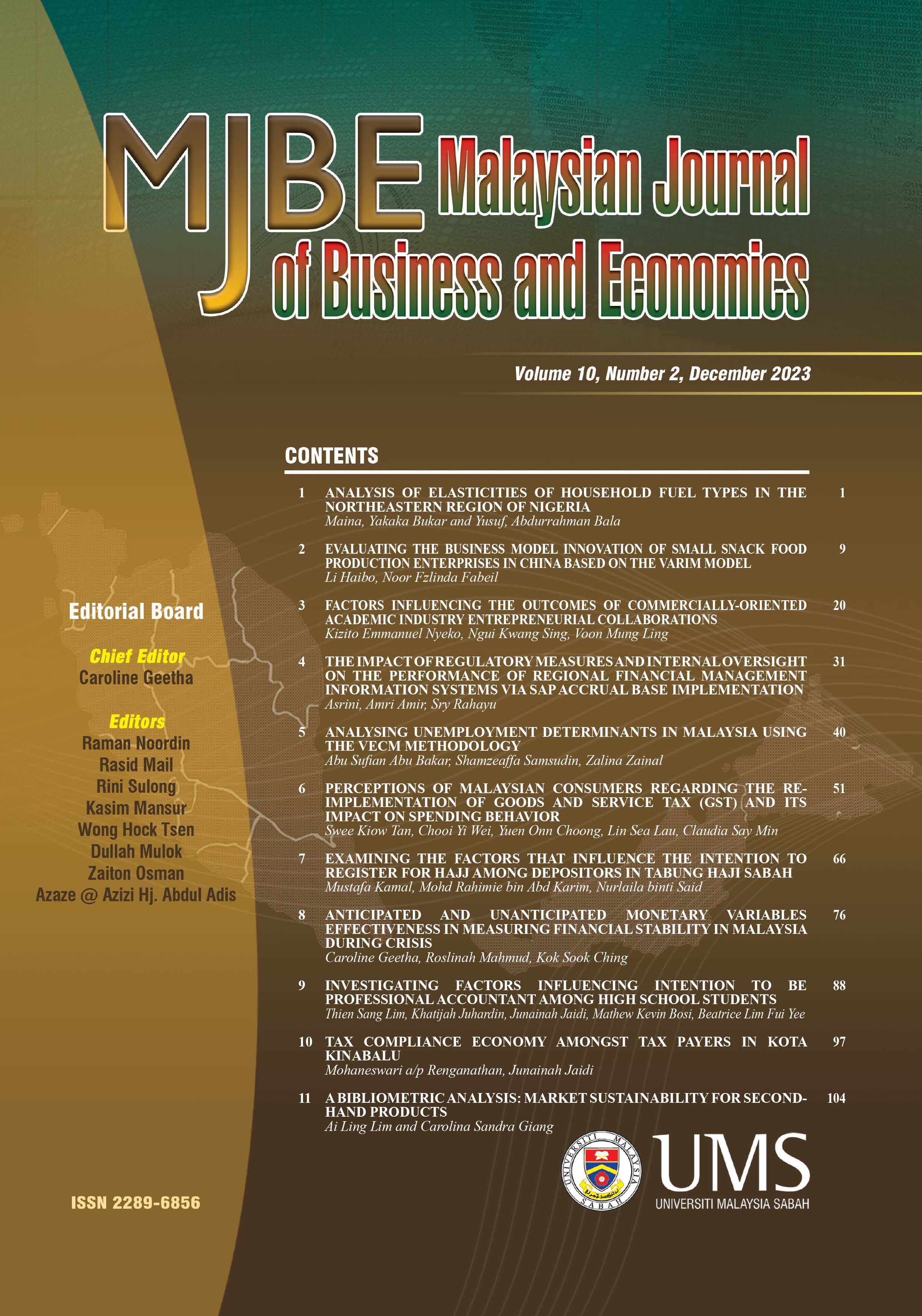ANTICIPATED AND UNANTICIPATED MONETARY VARIABLES EFFECTIVENESS IN MEASURING FINANCIAL STABILITY IN MALAYSIA DURING CRISIS
DOI:
https://doi.org/10.51200/mjbe.v10i2.4821Keywords:
anticipated, unanticipated, monetary variables, financial stability, crisis, Malaysia JEL Codes:E43, E44, E52Abstract
This study aims to investigate whether the anticipated and unanticipated changes in monetary variables can influence stock returns during a crisis. The financial stability was measured by the stock returns which was the dependent variable of the study. The independent monetary variables used were the interest rate, inflation rate, exchange rate, money supply and the GDP. All the variables were measured in the form of anticipated and unanticipated monetary variables. The analysis began with a unit root test that revealed that both anticipated and unanticipated monetary variables were having unit root problems at level but not at 1st difference. Thus, the variables were found to be integrated at 1st difference. The ARDL method was used to establish the long-run relationship and error correction modelling for the short-run relationship. Monthly data from January 2010 to September 2020 were used. The anticipated monetary variables did have a long-run relationship with stock returns, but all the monetary variables were insignificant at a 5 per cent significance level. However, the anticipated monetary variables did establish a short-run relationship with stock returns. Unfortunately, when unanticipated monetary variables were used both short-run and long-run relationships were established. All the unanticipated monetary variables were significant in explaining the changes in the stock returns except for the unanticipated interest rate.
References
Abdul Aleem. (2010). Transmission mechanism of monetary policy in India. Journal of Asian Economics, 21(2), 186-197.
Ahmed,R., & Mustafa, K. (2003). Real Stock Returns and Inflation in Pakistan. Department of Economics, University of Karachi.
Asteriou, D., & Hall, S. (2007). Applied Econometrics: A Modern Approach. Palgrave Macmillan.
Barro, Robert, J. (1980). Federal Deficit Policy and the effects of public debt shocks, NBER Working Paper Series. Working Paper No. 443. National Bureau of Economic Research.1050 Massachusetts Avenue Cambridge.
Chen, Nai-Fu, Roll, Richard & Ross, Stephen. A. (2004). Economic forces and stock returns. Journal of Business, 59(3), 383-403.
Disyatat, Piti. & Vongsinsitikul, Pinarat. (2003). Monetary policy and the transmission mechanism in Thailand. Journal of Asian Economics, 14(3), 389-418. https://10.1016/S1049-0078(03)00034-4.
Dickey, David. A., & Fuller, Wayne. A. (1979). Distribution of the estimators Autoregressive Time Series with a unit root. Journal of American Statistical Association, 74 (366a), 427-443.
Engle, R., & Granger, C. (1987). Cointegration and error correction: Representation, estimation, and testing. Econometrica, 55, 251-276.
http://dx.doi.org/10.2307/1913236
Glynn, John, Perera, Nelson & Verma, Reetu. (2007). Unit root tests and structural breaks: A survey with applications. https://ro.uow.edu.au/commpapers/455.
Hoffman, Dennis. L. (1986). Two-step generalized least squares estimators in multi equation generated regressor models. The Review of Economics and Statistics, 69 (2), 336-346. https://doi.org/10.2307/1927242
Johansen, S. (1991). Estimation and hypothesis testing of cointegration vectors in Gaussian Vector Autoregressive Models, Econometrica, 59(6), 1551–1580.
–––––. (1995). Likelihood-Based Inference in Cointegrated Vector Autoregressive Models (New York: Oxford University Press).
Kutty, G. (2010). The relationship between exchange rates and stock prices: The case of Mexico. North American Journal of Finance and Banking Research, 4(4), 1-12.
Kamin, Steven. Turner, Philip & Van’t dack, Josef. (1998). The transmission mechanism of monetary policy in emerging market economies: An overview, Policy Paper No. 3. Monetary and Finance Department, Bank of International Settlement. Basle.
Lucas, Robert E., & Sargent, Thomas J. (1981). Rational Expectations and Econometric Practice: Volume 1. NED New Edition. University of Minnesota Press.
Frederic S. Mishkin. (1991). Anatomy of a Financial Crisis, NBER Working Papers 3934. National Bureau of Economic Research, Inc.
Muth, John. F. (1961). Rational expectations and the theory of price movements. Econometrica, 29(3), 315-335.
MH. Pesaran, Y. Shin, RJ. Smith. (2001). Bounds testing approach to the analysis of level relationship, Journal of applied econometrics, Wiley, 16(3), 289-306.
Ooi Sang Kuong. (2020). Cari Asean, Research and Advocacy. https://www.cariasean.org/about-us/advisors-fellows/ybhg-dato-ooi-sang-kuang/#.YiYiJh7mgwA.
Ross, Stephen. A. (1976). The arbitrary theory of capital asset pricing. Journal of Economic Theory, 13(2), 341-360. https://doi.org/10.1016/0022-0531(76)90046-6.
Ufuk Can, Mehmet Emin Bocuoglu & Zeynap Gizem Can. (2020). How Does Monetary Transmission Mechanism work? Evidence from Turkey, Bolsa Istanbul Review: https:// 10.1016/j.bir.2020.05.004.
Yiswaree Palansamy. (2021). Deputy Minister: No fixed allocation for Nadma's Covid-19 Fund for 2022 as fund derived from public donations, government will add in a new wave. https://Malaysia.news.yahoo.com/deputy-minister-no-fixed-allocation-053100930.html.
Downloads
Published
Versions
- 31-12-2023 (2)
- 31-12-2023 (1)
How to Cite
Issue
Section
License

CCBY (Attribution)
https://creativecommons.org/licenses/by/4.0/
© Universiti Malaysia Sabah 2025
All rights reserved. No part of this publication may be reproduced, distributed, stored in a database or retrieval system, or transmitted, in any form or by any means, electronic, mechanical, graphic, recording or otherwise, without the prior written permission of Universiti Malaysia Sabah Press, except as permitted by Act 332, Malaysian Copyright Act of 1987. Permission of rights is subjected to the journal.









